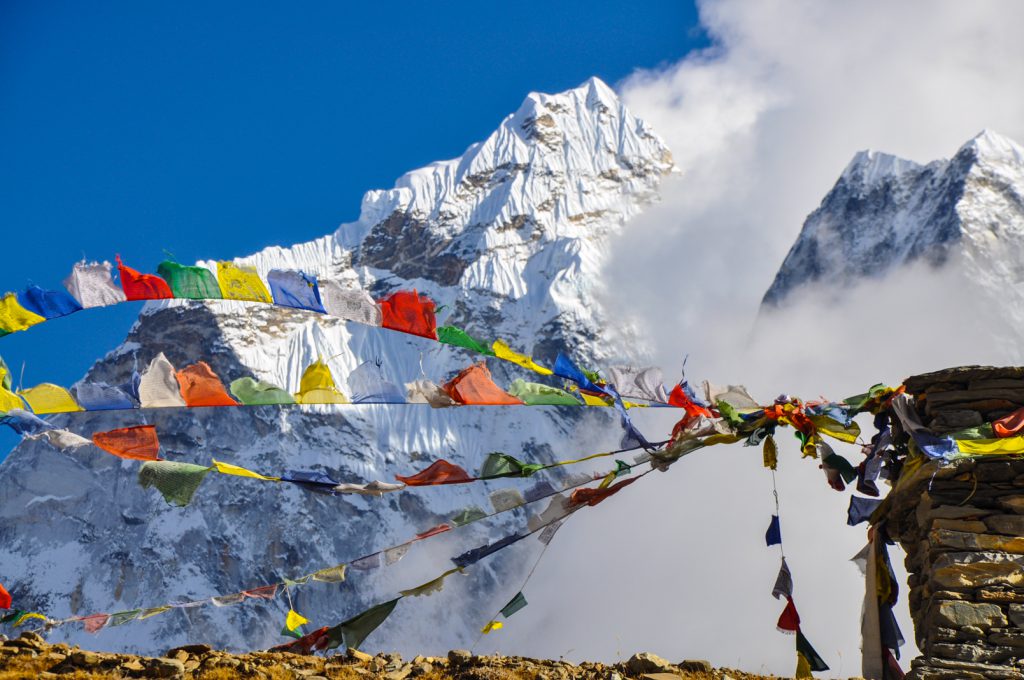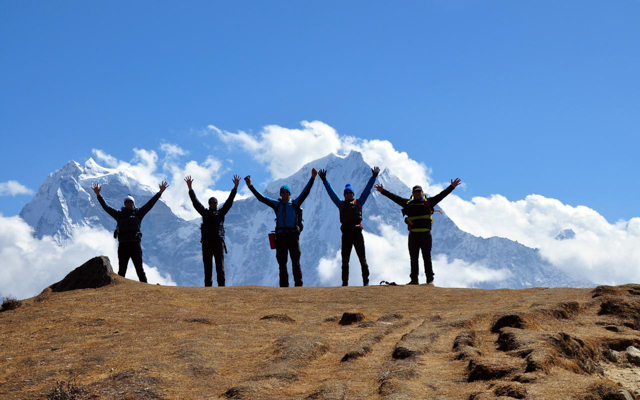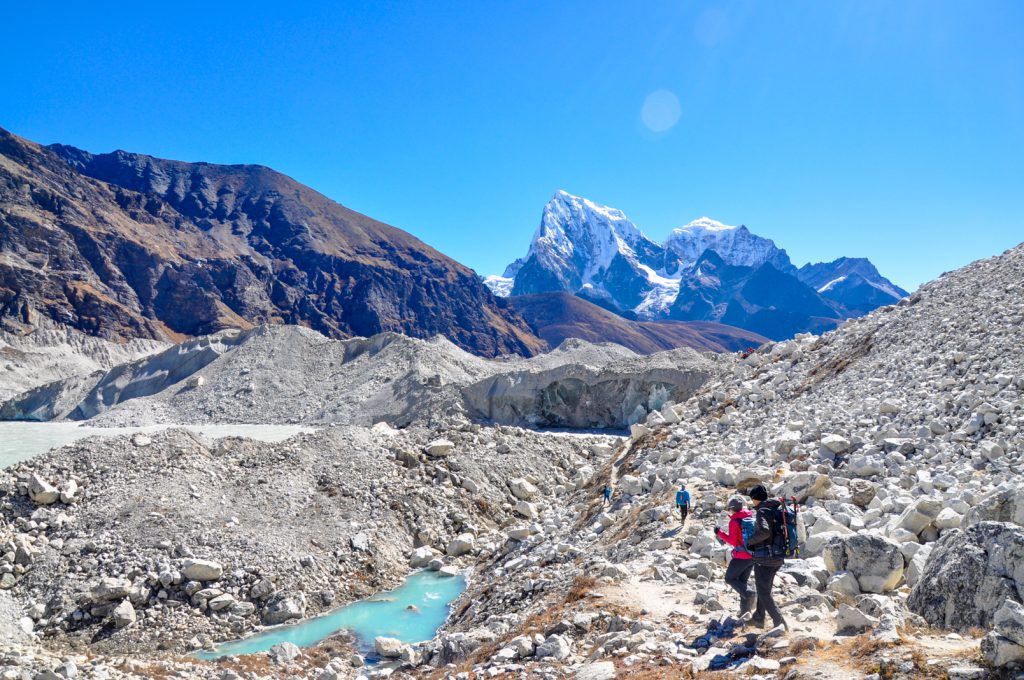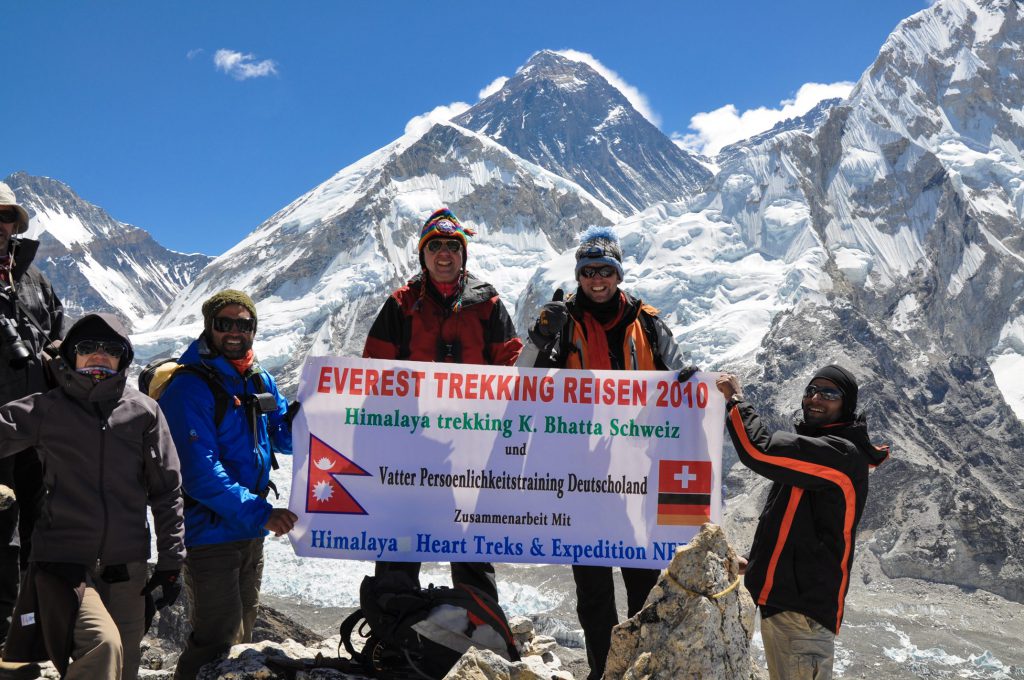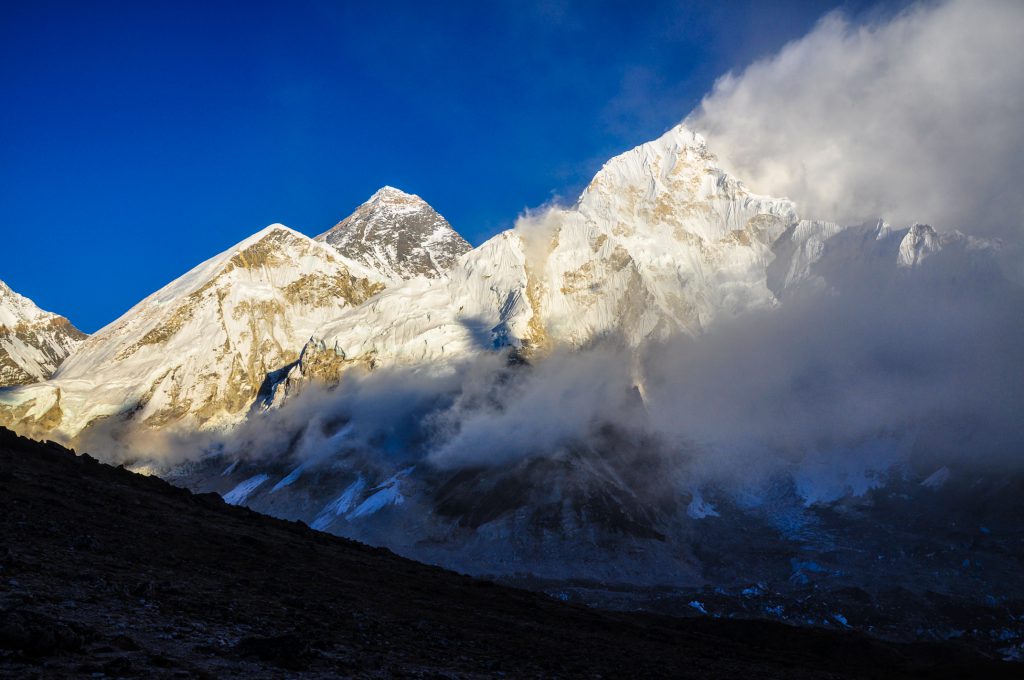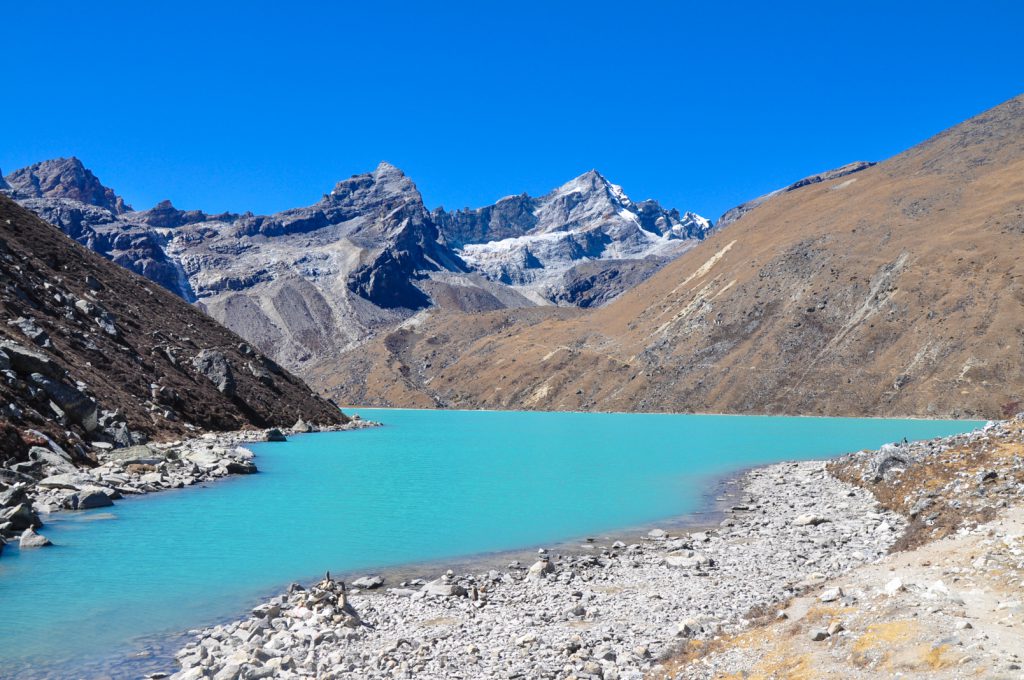Some journeys are worth stepping out of one’s comfort zone, this is definitely one them. A journey to Everest Base Camp via Gokyo Lakes provides spectacular mountain views as you hike the grandest mountain scenery on this planet. The highlights among many along the trek include weathered Sherpa villages especially Khumjung, the pristine blue Gokyo Lake and of course the breathtaking panoramic scenery the pass provides. All of this before reaching Base Camp where it is impossible not to be awe-struck by the sight of the snow-capped monster mountains dominating the skyline all around you. Including the 8,000m peaks of Lotse and Nuptse, and of course Mt Everest itself.
The route takes us deep into the heart of Nepals hardiest people with Sherpa culture at its best. We visit the largest Buddhist monastery in the Khumbu region at Tyangboche where we are able to appreciate the beauty of both its gompa and its setting. The power of nature is apparent as we hike through the boulder fields left in the wake of the extraordinary Khumbu Glacier. Although challenging and physically demanding at times, this trek takes you off the beaten trail and provides the ultimate adventure experience in the region.
Himalaya Heart will look after you all the way. Our mountain guides have spent many years leading groups at high altitude and are well able to deal with any problems. Our teams are always well prepared, we provide our porters and support staff with excellent equipment for travel into the mountains. Your trip leader will be paying careful attention to all clients and staff, making sure everyone stays as comfortable as possible and has the best chance of attaining their goals and completing the trip successfully.
Please note:
Delays with Lukla flights: These can happen any time of year, but are especially likely around monsoon season (late May to early Sept.). If your flight is delayed Himalaya Heart will reschedule you on the next possible flight. As conditions can change rapidly this may be very soon after your scheduled departure, or on very rare occasions be as much as a few days later – it is very difficult to predict. This can be pretty frustrating, but is simply part of the journey to the Everest region. We strongly recommend you add at least a day or two to the end of your trip if you have an international connecting flight to give yourself some flexibility in the case of any delays.
- The perfect place to enjoy a high elevation trekking adventure
- Lush nature in the lower parts of the trek
- Exploring the glacial lakes at Gokyo
- Crossing Cho La – a high mountain pass
- Trekking to Everest Base Camp (5,364m)
- Trekking to Kalapatthar (5,545m)
- Spectacular mountain views
- Cultural sightseeing tour in Kathmandu
A Himalaya Heart representative will welcome you at the airport and take you to the hotel where we will talk about the trip in more detail. This is an opportunity for you to ask any question you may have. The rest of the day is free to relax and explore.
A cultural exploration day is planned in Kathmandu today. A full day sightseeing tour of Kathmandu . We visit many of the historic and cultural sites during the day where you will learn something about the life in the capital city. The tour today mixes Nepals rich heritage and history with its so evident spirituality together to give provide an exceptional city touring experience.
Get ready its time to go! we need to take an early morning flight to Lukla in the Everest region around 40 minutes with some scenic views of forested hills and snow-capped mountains on the way.After our arrival at Lukla we begin an easy days trek to Phakding We follow the east bank of the Dudh Koshi River. passing by small settlements, before reaching Phakding.
The trail today follows up the Dudh Koshi Valley, hiking through beautiful pine forest, crossing the river twice via small suspension bridges before reaching the village of Monjo. Monjo is the entrance gate of the Sagarmatha National Park where our documents are checked. After entering the park there is a slight climb to Jhorsalle, the trail passes waterfalls with a lot of bio diversity on the way. Today we are rewarded with our first glimpse of Kusum Kanguru (6369m) Thamserku (6608m), Everest (8848m) and Nuptse (7879 m). A steep climb up to the beautiful large village of Namche Bazaar (3440m) a lively colorful center of trade where many tradespeople come to haggle and sell their wares.
As we are going to be at over 5000 metrs in a few days we need to spend a day here allowing our systems to get used to the higher altitude. Set in a beautiful natural amphitheater, Namche Bazaar is one of the most attractive settlements in the Khumbu region. This is a good opportunity today to make short acclimatization treks.We go up to Khumjung, a lovely Sherpa village above Namche visit The Everest View Hotel from where there are wonderful panoramic views of Everest, Ama Dablam, Thamserku, Nuptse, Lhotse, Tawche, and Kwangde . Ther back down to pick up on the atmosphere Namche provides.
We leave Namche Bazaar on a trail with gradual ups and downs. There is a lot of bird and wildlife today. Himalayan pheasants, musk deer and Himalayan Thar on the way if we are lucky. Our trail descends to Dudhkoshi Khola before an uphill climb through rich rhododendron forests to finally reach Phortse. From here we get some splendid views of the peaks Tawache and Cholaste. Overnight in Phortse.
After crossing a bridge over the Dudh Koshi River, today is another day for local wildlife pheasants, mountain goats, and musk deer are common here. Our trail passes through forests, waterfalls and bridges before reaching Dole. We climb on a steady trail along a scenic ridge with views of Cho Oyu, Kantega, and Thamserku mountains. Onwards to ascend from Luza village and walk above the Dudh Koshi River. The trail leads through small villages along sandy trails before reaching Machhermo. At 4410m, Machermo is ideally situated to provide a much needed rescue service, a dormitory and a kitchen for porters plying the upper reaches of the Gokyo valley and the passes leading into it (Renzo La 5600m and Cho La 5420m). The rescue service is also available to trekkers.It provides lectures on the affects of altitude sickness, its precaution, and primary treatment. Overnight in Machhermo.
Leave early for a longish walk this morning – we need to take plenty of liquids and some snacks – chocolate etc. The trail climbs up a ridge where we have some excellent views looking back down the valley to Kangtaiga and up the valley to Cho Oyu. Beyond the ridge, the valley widens as the trail passes through Pangna where we take a welcome tea stop before a descent to the riverbank and up onto the terminal moraine of the Ngozumpo Glacier. It slow as we go from here. The trail climbs steeply up the moraine, switch backing alongside the stream on our way to the first small lake, called Long pongo. This is hard work, it takes about three hrs to reach the first lake. The trail thankfully levels off as it follows the valley past a second lake and finally up a boulder strewn path to Gokyo. There are several lodges and walled pastures on the shore of the lake. We stay overnight in Gokyo.
This is a special day a hike to Gokyo Ri (5,360m). We start walking towards the base of Gokyo Ri after breakfast the only kind of trekking peak in Khumbu region.It takes around three hours of steady push. Once at the top there are some superb views of Mt. Everest, the massive Ngozumpa Glacier and the whole of Khumbu Himalayan Range including Mt. Lhotse, Mt. Nutse, Mt. Makalu (8481m), Mt. Cho-Oyu (8153m) and Mt. Gychung Kang (7922m). If there is enough time, we can take a walk around Gokyo Lake before heading back to our lodge.
After a full day and amazing day exploring the mountain views and the surroundings of the lakes, we trek to Thagnag today. An easy day but every day in the mountains is full of wonders. Thagnag is a small and peaceful settlement amidst the mountain surroundings.We have plenty of time to look around.
Our Cho La day has arrived, we have to start very early to make the most of it.High Himalayan feelings as we head towards the pass standing at a proud 5,420 meters above sea level. The trail is challenging with a lot of rough land to be dealt with and a steep ascent, that whilst not requiring any technical climbing can be very tricky at times. The top of the pass at last brings yet another spectacular view of these monsters..just breathe and take it all in this is heaven.We have a tricky descent to contend with before the trail levels off on our way to Dzongla and overnight.
Our walk today eventually brings us to Lobuche where we meet the regular trail to Everest Base Camp that we left behind at Namche Bazar. This is another very rewarding day with stunning views a lot of the way.
From Lobuche we follow the narrow gap between the glacial moraine and the mountain walls, we can make a detour to the edge of moraine to look over the Khumbu glacier. Wonderful views of Mt. Pumori, Nuptse, and other magnificent peaks on the way to reach Gorakshep which is the original location of the Everest Base Camp.The new camp is situated further up the valley.
After lunch we continue to Everest Base Camp Distance 3.5 km one way. The trail passes over rocky moraine and several small streams. At Base Camp we have the opportunity to experience the freezing and harsh conditions that mountaineers brave to summit this famous mountain. It is a place for climbers to gather to make the final preparations. We explore base camp and its surrounding glacier before our return back to our lodge at Gorakshep.
We are hoping for the normal sparkling and clear day as we set off early to climb Kalapathar around 2 kms from Gorakshep. It is now you fully appreciate what this has been all about. Your efforts to reach here is rewarded by an almost surreal experience of the 360-degree dramatic panoramic view of Mt Everest and the surrounding mountains of Mt. Pumori, Mt. Lingtren, Mt. Khumbetse, Mt. Nuptse, Mt. Lhotse, Mt. Ama Dablam, Mt. Thamserku along with many other peaks in the range. Spend some time to gather your thoughts before we leave for the easy walk for about 2hrs to Lobuche and onwards downhill to Pheriche. Continue down moraine to Dughla and then drop to the bridge over a gushing stream that flows out of the glacier. Overnight Lodge.
A lovely day we are fully acclimatized and everything is easy especially as its downhill most of the way. We trek down a hillside blanketed by rhododendron and juniper trees full of wildlife; Pheasants, Himalayan Griffons, Musk deer and wild goats are all fairly common along with a huge variety of birds. It takes approximately four hours to reach Tyangboche.
From Tengboche we trek sharply down to the Dudh Kosi then after crossing a suspension bridge over the Dudh Koshi River we trek onwards to the Kyanjuma a junction where there is a choice of three trails to Gokyo Valley, Khumjung village, and Namche Bazaar. We follow the trail to Namche for some delicious food, hot showers and great accommodation.
The descent from Namche to the Dudh Koshi can be the hardest stage of the entire trek if you are not keen on downhills especially on the knees. Once we have crossed the suspension bridge high over the river, the path runs mostly level. A lovely trail through rhododendron and pine forests with distant views of snow covered peaks before we reach Phakding. We are now very close to our destination passing through local Sherpa villages to finally arrive in Lukla to perhaps celebrate with the team before our flight back to Kathmandu the following morning.
After breakfast, we say goodbye to the mountains for the flight back to Kathmandu. On arrival one of our reps will be waiting for the transfer back to the hotel.An evening meal is often arranged on the last day.
Today its time to move on we hope you have had a great time with us and we would like to meet again in the future. If you are flying today.we will drop you at the airport as per your flight schedule or assist you with any other move.
Cost Included
- Pick up & drop off on your arrival and departure
- Hotel accommodations in Kathmandu with breakfast
- Basic lodge accommodation during the trek
- A professional trekking guide and necessary number of porters [one porter in between two people]
- Trekking Entry permit and TIMS (Trekkers Information Management System)
- Breakfast, lunch, dinner during trek
- Kathmandu-Lukla-Kathmandu flight ticket
- Emergency rescue arrangement (Makes sure your insurance will cover it)
- Insurance for guide that includes their emergency rescue
- Necessary equipment for guide & porter
- First aid kits
Cost Not Included
- International flight fare and travel insurance
- Meals in Kathmandu
- Alcohol and any drinks on the trip
- Tips for guide and porters
- All expenses of a personal nature e.g. toilet paper, medicines, and confectionery etc.
- Any other cost raised by unforeseen circumstances
Everest Base Camp Trek via Gokyo Lakes FAQ's
You can bring your own light-weight sleeping bag from home or you can rent one in Kathmandu or Himalaya Heart will loan you one. Most tea houses also have blankets you can use; in the warmer months, you may just want a sleeping bag liner to use with the blankets, and in the colder months, you’ll want a warmer winter sleeping bag.
When’s the best time to visit Nepal?
The main seasons for trekking are the spring (Mar to May) and autumn (Sep to Nov) when you’ll have clear skies and superb mountain views. The winter (Dec to Feb) is also a great time to visit— these months offer a unique experience and fewer crowds but lower altitude treks are better at this time of year as its cold at night.
What’s it like during the monsoon season?
During the monsoon season (Jun to Aug), most of Nepal experiences heavy rain for a few hours each day. It’s humid, wet, and the trails in the lower regions (Ghorepani, Ghandruk, Langtang, etc) can be quite muddy. If you don’t mind the rain you’ll have the trails to yourself, the skies often clear up in the morning, and certain treks offer stone-paved trails that drain the rain and make for easy trekking. Also, certain regions, like Mustang and the upper reaches of Everest, lie in the rainshadow of the Himalaya and receive little rain but views however are still likely to be restricted.
What’s the difference between private and group tours?
Private tours are tailor-made itineraries built by us around your travel dates and personal interests, whereas group trips are pre-packaged and depart on specific dates. Group trips are also open for others to join, whereas private trips are just for you. You will find a list of fixed departure dates on our website.
How do I get my visa for Nepal?
For most nationalities, you can get your visa on arrival in Kathmandu. It takes around 45 minutes and is the most convenient way to get your visa you will need passport size photos.. You can also apply for a visa in advance from a local Nepali consulate in your country if you’d like to have everything arranged in advance. Cost15 Days – 25 USD / 30 Days – 40 USD / 90 Days – 100 USD
How much luggage can I take on domestic flights?
For mountain flights, you’re allowed 5 kg. carry-on to the plane and 10 kg. for checked-in luggage. For non-mountain sector flights, the check-in allowance increases to 20-25 kg.
How many days should I spend in Nepal?
If you’re mainly looking to experience Nepal’s cultural and natural highlights, you can have a great experience in 5-9 days, where you can visit two regions (likely Kathmandu and Pokhara perhaps go on Safari at Chitwan). If you intend to go trekking consider at least 10 days (more is better) to have enough time to reach higher altitudes and safely acclimatize if need be.To undertake one of the longer, classic treks in Nepal or to combine multiple regions and activities into one visit, think about 14-20 days and more if possible.
Are hotels included in the tour price?
Himalaya Heart organises complete tours, meaning everything is taken care of from the moment you arrive in Nepal to the moment you leave, including all of your accommodation in a three star Hotel. If you require better accommodation please let us know and we can arrange this and adjust the tour cost accordingly. Each of our tour pages shows clearly what is and what is not included in the tour price.
Are there any extra expenses not included in my tour price?
Personal expenses (tips, soft drinks, bar bills, laundry, telephone calls, donations, and extra snacks, etc) are not included in your tour price. When checking a particular trek page on our website we have clearly stated what is and what is not included. If you’re going trekking, the only things you’ll need to pay for out of pocket are wifi and battery charging (when available), extra meals outside of what’s included, alcohol, and soft drinks and perhaps hot showers.

 +977 9851093973 (Thakur)
+977 9851093973 (Thakur)